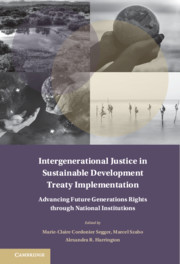 Intergenerational Justice in Sustainable Development Treaty Implementation
Intergenerational Justice in Sustainable Development Treaty Implementation Book contents
- Intergenerational Justice in Sustainable Development Treaty Implementation
- Treaty Implementation for Sustainable Development
- Intergenerational Justice in Sustainable Development Treaty Implementation
- Copyright page
- Contents
- Figures
- Tables
- Notes on Contributors
- Foreword
- Acknowledgements
- Abbreviations and Acronyms
- 1 Introduction
- 2 The Theoretical Framework for International Legal Principles of Intergenerational Equity and Implementation through National Institutions
- Part I Introduction to Treaty Law on Intergenerational Justice and Codifying Sustainability
- Part II Key Challenges in Domestic Implementation of Intergenerational Justice
- Part III Law and Policy Innovations for Intergenerational Justice
- Part IV Implementing Sustainability through National Institutions: Case Studies
- National Case Studies
- Comparative Insights
- 29 A Comparative Analysis of Model Institutions: Diversity in Reaching Common Goals
- 30 Comparing Progress in Intergenerational Governance
- 31 International Institutions for Future Generations and Democratic Legitimacy
- Part V Regional Trends in Intergenerational Justice
- Part VI Future Trends
- Afterword
- Table of Authorities
29 - A Comparative Analysis of Model Institutions: Diversity in Reaching Common Goals
from Comparative Insights
Published online by Cambridge University Press: 15 October 2021
- Intergenerational Justice in Sustainable Development Treaty Implementation
- Treaty Implementation for Sustainable Development
- Intergenerational Justice in Sustainable Development Treaty Implementation
- Copyright page
- Contents
- Figures
- Tables
- Notes on Contributors
- Foreword
- Acknowledgements
- Abbreviations and Acronyms
- 1 Introduction
- 2 The Theoretical Framework for International Legal Principles of Intergenerational Equity and Implementation through National Institutions
- Part I Introduction to Treaty Law on Intergenerational Justice and Codifying Sustainability
- Part II Key Challenges in Domestic Implementation of Intergenerational Justice
- Part III Law and Policy Innovations for Intergenerational Justice
- Part IV Implementing Sustainability through National Institutions: Case Studies
- National Case Studies
- Comparative Insights
- 29 A Comparative Analysis of Model Institutions: Diversity in Reaching Common Goals
- 30 Comparing Progress in Intergenerational Governance
- 31 International Institutions for Future Generations and Democratic Legitimacy
- Part V Regional Trends in Intergenerational Justice
- Part VI Future Trends
- Afterword
- Table of Authorities
Summary
In 2013, the Secretary-General of the UN named eight institutions as models for considering intergenerational solidarity and representing the interests of future generations in policy making. Each institution has its own unique set of characteristics as a result of constitutional backgrounds, functions, and organisational structures, to name only a few characteristics. Additionally each institution has found its own set of theoretical bases and principles upon which to pursue its activities and reach its goals. This comparative study of the model institutions is to identify the set of most important features, including not just references to legal framework, organisational structures, but also missions, aims, and goals, and theories and principles by which they can be characterised. This will be done by placing each institution within this set of criteria, assessed and drawn from existing practice, in which links between the various aspects are highlighted, and it is shown how theories can be operational in practice. The chapter argues for and reflects on the innovative characteristics of model institutions for sustainable development when the theoretical basis – especially legal theory – is lagging behind.
- Type
- Chapter
- Information
- Intergenerational Justice in Sustainable Development Treaty ImplementationAdvancing Future Generations Rights through National Institutions, pp. 546 - 575Publisher: Cambridge University PressPrint publication year: 2021


